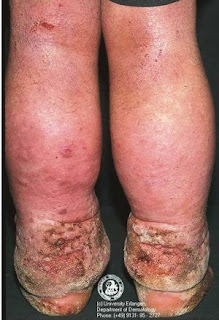1. Ichthyosis
It is a skin
disorder wherein there is an excessive amount of dry surfaced scales that
happens at an early age. This is hereditary, meaning; it can be passed on to
the next generation. It is classified because of the abnormal epidermal
differentiation or metabolism, making a person look like a tree.
2. Fibrodysplasia Ossificans Progressive
This is a disorder on connective
tissues and muscle tissues like ligaments and tendons, wherein there is a new
bone being formed outside the skeletal system that limits the movement of the
individual, induces the inability to talk, and limited diet that later would
result to malnutrition. The ratio for this disease is 1 out of 2 million people
in the world.
3. Argyria
It is strongly characterized with a
blue or gray discoloration on the skin, which is caused by an excessive
exposure from silver or an ingestion of silver salts, which are found in
certain medical prescriptions. People who are prone to have this disease are
those who work in mining industries that works on silver extraction and even
those who are doing photographic processing.
4. Pica Syndrome
This is a kind
of disorder that typically happens to children and pregnant women wherein there is a strong craving to
eat non-food substances or materials such as paper or dirty items. This
condition is actually associated to a bird called magpie that tends to eat
anything. It is really common to women and children. It could be diagnosed as
mental autism for the kids, which is believed to be caused by mineral
deficiency such as iron.
5. Blaschko Lines
These are skin lines, which cannot
be seen under normal situations. It can be seen if there are triggering skin
diseases where patterns become apparent or visible at all. It appears on wavy
shapes on the head, chest, sides, and stomach. According to studies, it is
caused by the migration of the embryonic cells, which are not in line with the
human muscular and lymphatic or nervous system. In fact, this is found on
animals like dogs and cats.
It is a
neurological disorder where the 6th to 7th cranial nerves are affected. It
includes the eye and face muscles that results to partial or total facial
paralysis. If this occurs to babies, there is a strong inability for the child
to be fed through sucking. Some other characteristics of this disease are
crossed eyes, inability to move the head, lack of facial expressions, and
inability to smile. This happens when the facial nerves are underdeveloped,
which is identified to genetic causes that have not yet been proven.
7.
Cutaneous horns
These are uncommon keratinous skin
tumors, which are in the form of horns. It grows on human feet and hands. In
most cases, it is benign. But at times, premalignant or malignant. This happens
to adults, especially those who are frequently exposed in the sun and have fair
skin where lesions might occur thereafter.
8. Elephantiasis
This is opposite of the
Ehlers-Danlos Syndrome wherein there is a thickening process that happens on
the skin that most commonly happens in the legs of most males. This is also
called as Lymphatic Filariasis, which is actually caused by parasitic worms
called Wuchereria Bancrofti, B. Timori, and Brugia Malayi that affects the
lymphatic system. This is done through transmission being carried by
mosquitoes. It is an extreme case of large inflammation that can be found on the
head, torso, and limbs.
9. Ehlers-Danlos Syndrome
The other term for this is Cutis Hyperplastic,
which is actually a defect, found in the synthesis of collagen with a group of
inherited connective tissue disorders. When collagen is not developed, it
affects the right form of the body that would cause human deformity. As another
term stated, there is an extensive elasticity occurring on the skin and few of
the individuals who are diagnosed of it has very thin skin.
10. Werewolf Syndrome
It is called werewolf because there is an abnormal
amount of hair growth on the human body parts such as the face, arms, and
hands. Nonetheless, in medical terms, it is called as Hypertrichosis or Ambras
Syndrome. It can be classified as localized hypertrichosis or the generalized
type. Studies have shown that it can be congenital, which means that an
individual has it on his or her genes even before birth or it can be acquired.









Nenhum comentário:
Postar um comentário